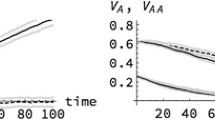Summary
If genetic and environmental effects upon a quantitative phenotype X=G+E are normally and independently distributed then the probability distribution of genetic value G among individuals of fixed phenotypic value X is likewise a normal distribution. The mean of this a posteriori distribution of genetic values is \(\bar g\)+h 2 (X−\(\bar g\)) and the variance is σ 2 g (1−h 2), where \(\bar g\) is the a priori mean of X, h 2 is the heritability ratio, and σ 2 g is genetic variance. For any fixed values of h 2 and σ 2 g the a posteriori probability that the genetic value G associated with a given phenotype X exceeds the population mean by any specified amount can therefore be read directly from the tables of the standard normal distribution. The expected proportion of these superior genetic deviates among individuals whose phenotypic value exceeds some specified constant may also be calculated (by numerical analysis) and is presented here in graphical form.
If phenotypic selection is practiced by choosing the best out of N phenotypes then N should be large enough to assure high probability of obtaining a superior genetic deviate. The operating characteristics of this type of selection are displayed in tabular form, again based upon numerical integration.
Zusammenfassung
Wenn genetische und umweltbedingte Effekte auf einen quantitativen Phänotyp X=G+E von einander unabhängig und normal verteilt sind, dann entspricht die Wahrscheinlichkeitsverteilung des genetischen Werts G unter Individuen mit fixiertem phänotypischem Wert X gleichfalls einer Normalverteilung. Das Mittel dieser a posteriori-Verteilung der genetischen Werte ist \(\bar g\)+h 2 (X−\(\bar g\)) und die Varianz ist σ 2 g (1−h 2); wobei \(\bar g\) das a priori-Mittel von X, h 2 der Heritabilitätskoeffizient und σ 2 g die genetische Varianz sind. Für jeden fixierten Wert von h 2 und σ 2 g kann daher die a posteriori-Wahrscheinlichkeit, daß der genetische Wert G das Populationsmittel in Verbindung mit einem gegebenen Phänotyp X um einen bestimmten Wert übersteigt, direkt aus den Tabellen einer standardisierten Normalverteilung abgelesen werden. Der erwartete Anteil dieser überlegenen, genetisch bedingten Abweichung unter Individuen, deren phänotypischer Wert einen vorgegebenen Konstantwert übersteigt, kann ebenfalls numerisch errechnet werden. Er wird im vorliegenden Fall graphisch dargestellt. Wenn eine phänotypische Selektion zur Auswahl der besten Phänotypen aus N Individuen erfolgt, sollte N groß genug sein, um mit hoher Wahrscheinlichkeit eine überlegene, genetisch bedingte Abweichung zu erhalten. Die wirksamen Charakteristiken dieses Typs der Selektion werden in tabellierter Form wiedergegeben, die gleichfalls auf numerischer Integration beruht.
Similar content being viewed by others
Literature
Cochran, W. G.: Improvement by means of selection. Proc. Second Berkeley Symposium on Mathematical Statistics and Probability, pp. 449–470 (1950).
Dudley, J. W., and LeRoy Powers: Population genetic studies on sodium and potassium in sugar beets (Beta vulgaris L.). J. Amer. Soc. Sugar Beet Tech. 11, 97–127 (1960).
Eisenhart, C.: The assumptions underlying the analysis of variance. Biometrics 3, 1–21 (1947).
Federer, W. T., LeRoy Powers, and M. G. Payne: Studies on statistical procedures applied to chemical genetic data from sugar beets. Colorado Agr. Exp. Sta. Tech. Bul. 77. 39 pp. (1963).
Powers, LeRoy: Strawberry breeding studies involving crosses between the cultivated varieties (X Fragaria ananassa) and the native Rocky Mountain strawberry (F. ovalis). J. Agr. Res. 70, 95–122 (1945).
Powers, LeRoy, D. W. Robertson, and A. G. Clark: Estimation by the partitioning method of the numbers and proportions of genetic deviates in certain classes of frequency distributions. J. Amer. Soc. Sugar Beet Tech. 9, 677–696 (1958).
Powers, LeRoy, E. E. Remmenga, and N. S. Urquhart: The partitioning method of genetic analysis applied to a study of weight per root and percentage sucrose in sugarbeets. Colorado Agr. Exp. Sta. Techn. Bul. 84. 23 pp. (1964).
Author information
Authors and Affiliations
Additional information
Dedicated to Dr. George F. Sprague on the occasion of his 65th birthday.
Cooperative investigations of the Colorado Agricultural Experiment Station, the Crops Research Division, Agricultural Research Service, U.S. Department of Agriculture, and the Beet Sugar Development Foundation. Approved by the Colorado Agricultural Experiment Station for publication as Scientific Series Article No. 880. Paper No. BU-78, Biometrics Unit, and Paper No. 529, Plant Breeding Department, Cornell University.
Geneticist, Crops Research Division, Agricultural Research Service, U.S. Department of Agriculture; now deceased.
Formerly Research Assistant, Colorado State University; now Assistant Professor of Biological Statistics, Cornell University.
Rights and permissions
About this article
Cite this article
Robson, D.S., Powers, L. & Urquhart, N.S. The proportion of genetic deviates in the tails of a normal population. Züchter / Genet. Breed. Res. 37, 205–216 (1967). https://doi.org/10.1007/BF00329530
Issue Date:
DOI: https://doi.org/10.1007/BF00329530




